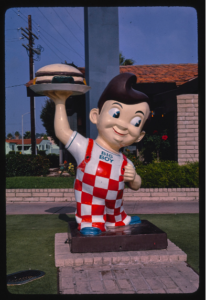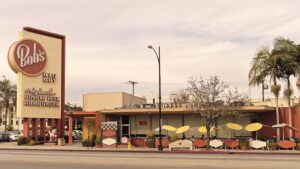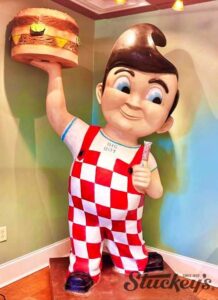In 1933, the graduating class of Glendale High School in Glendale, California, included a young man by the name of Robert C. Wian.
Bob’s father, a furniture salesman, had moved the family to Glendale from Philadelphia just four years earlier in 1929. However, when the Great Depression hit later that year, Bob’s father went bankrupt. This forced Bob into working as a dishwasher at the school’s cafeteria to pay for his lunch.
What’s more, hardly ever taking home any homework, Bob wasn’t remembered for being much of a scholar at Glendale High and his classmates never thought he’d amount to much. In fact, the class of 1933 voted Bob “Most Likely Not to Succeed”.
After graduation, Bob soon took a job as a dishwasher at a local coffee shop, and it seemed that perhaps his classmates may have been right. However, what they didn’t know was that Bob had bigger plans for himself in mind and he wasn’t going to let his father’s failure or his classmates’ doubts discourage him from reaching them.
Congratulations! It’s a Boy!
For the next three years, Bob worked at a number of different well-known restaurants in the area. He’d usually start out as a dishwasher and then work his way up to counterman or cook, gaining as much experience as he could before moving on to the next job.
Eventually, Bob would sell his car for $300 as down payment on a little 10-stool hamburger stand there in Glendale, borrow $50 more dollars from his father for meat and other supplies, and open up his own business he called “Bob’s Pantry” in 1936.
Six months after opening, a customer walked into Bob’s Pantry one night claiming he was bored with eating the same old hamburgers night after night. He asked Bob to make him something different, so Bob took a hamburger bun, sliced it into three pieces creating a middle bun and put a hamburger between each of the slices. Bob Wian, the young man who was voted most likely to not succeed had just invented the world’s first double-decker hamburger nearly 30 years before anyone ever heard of something called a “Big Mac”.

The name of the burger came about quite by accident, however. Around the same time that Bob invented the double-decker hamburger, a chubby 6-year old boy named Richard Woodruff would hang around and do odd jobs for Bob at the hamburger stand. Bob forgot his name one day and called out, “Hey, Big Boy!” Suddenly a light bulb went off in Bob’s head, and he had a name for his new burger – “Bob’s Big Boy”.
The Big Boy Gets Bigger
Around the same time he invented the Big Boy, Bob also had a 21-year-old fry cook by the name of Ben Washam working for him. Using the young Woodruff as his model, Washam would create a caricature of the chubby little boy that would become the restaurant’s famous mascot. (Woodruff, incidentally, would later go on to work as an animator for Warner Bros.)
Because of the popularity of Bob’s Big Boy burger, the restaurant soon became a local chain, opening under such names as “Bob’s”, “Bob’s Drive-Ins”, and more commonly, “Bob’s Big Boy”.
In the late 1940s, however, Wian’s wanted to expand Big Boy nationally. To reach that goal, he licensed three operators in the East to sell his Big Boy hamburger: Frisch’s Big Boy in Cincinnati, Eat’n Park Big Boy in Pittsburgh, and Shoney’s Big Boy of Charleston, West Virginia. In fact, it was Shoney’s founder Alex Schoenbaum who would convince Wian to franchise Big Boy throughout the 1950s with all franchises using their own name with the Big Boy trademark instead of Bob’s.
To tie all of the franchises together, Manfred Bernhard was hired to create a new Big Boy mascot. Bernhard thought the old Big Boy sloppily drawn and his expression goofy. As a result, he created what became known as The “West Coast Big Boy” mascot we know today with brown hair swept up in a pompadour, checkered overalls and black shoes. Though there would be a modified “East Coast Big Boy” version with blonde or red hair, side cap, saddle shoes, and striped overalls used by Frisch’s and Shoney’s Big Boys around the mid-1950s, nearly all Big Boy franchises have been using the West Coast version since 1956. This version is the one that would be used for menus, comic books, and fiberglass statues.

Speaking of Statues
Though there have been variations of it throughout the years, the original West Coast Big Boy statues were a whopping 16 feet tall and always featured the Big Boy hamburger held aloft by the mascot’s right hand. Later incarnations of the Big Boy would come in difference sizes with some even having both hands clutching his suspenders, getting rid of the hamburger altogether.
The Big Boy franchise reached its peak in 1989 with over 240 restaurants nationwide. Unfortunately, for a number of different reasons, there are only 64 locations around the U.S. today according to the data company ScrapeHero. (One of the most recent closings was the Sandusky, Michigan location which lost their franchise license in November 2020 after refusing to comply with COVID-19 restrictions.)
So what happens to the statues after a store closes? Well, some of them ended up in the Big Boy Graveyard that used to sit just west of Marquette, Michigan; however, they seem to be long gone now. Others have found their ways to museums like the Shoney’s Big Boy Museum in Charleston, West Virginia.
More recently, one has found a home at Stuckey’s.
Welcome to Stuckey’s, Big Boy

That’s right! We’ve recently purchased a Big Boy at an auction, and the over 7-foot-tall statue now proudly stands in our retail store in Wrens, Georgia, with the famous double-decker Big Boy burger in one hand and a Stuckey’s Pecan Log Roll in the other.
It’s all part of our efforts to renovate our retail store with a roadside Americana theme, so keep your eye out for more of your favorite roadside icons coming soon.
Meanwhile, the next time you’re traveling down U.S. Route 1 in Wrens, Georgia, stop in and see the Big Boy for yourself. We’ll have a pecan log roll and a smile waiting for you!
Of course, if you can’t wait that long to sink your teeth into one of our delicious Pecan Log Rolls, Pecan Pralines, or other delicious Stuckey’s treats, then head over to our website.
Browse our wide selection of classic pecan treats, road trip snacks, and other Stuckey’s branded merch including a variety of caps and tees to get you and yours ready for this summer’s road trips and family vacations by road.
Order yours today only from stuckeys.com.
Stuckey’s – We’re Making Road Trips Fun Again!
Whether your next road trip is by car or by rail, it’s not really a road trip without taking Stuckey’s along. From our world famous Stuckey’s Pecan Log Rolls to our mouthwatering Hunkey Dorey, Stuckey’s has all the road trips snacks you’ll need to get you where you’re going.
For all of the pecany good treats and cool merch you’ll need for your next big road adventure, browse our online store now!
Stuckey’s – We’re Making Road Trips Fun Again!
